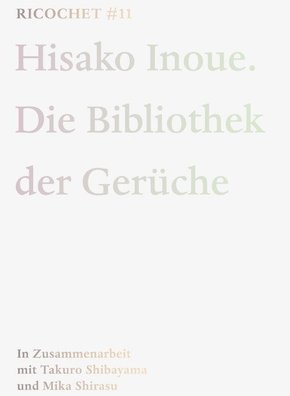| Verlag | Distanz Verlag |
| Auflage | 2017 |
| Seiten | 96 |
| Format | 16,6 x 24,4 x 0,8 cm |
| Gewicht | 298 g |
| Reihe | Ricochet 11 |
| ISBN-10 | 3954762188 |
| ISBN-13 | 9783954762187 |
| Bestell-Nr | 95476218A |
Die ästhetische Bewertung von GerüchenDie Gerüche antiquarischer Bücher stehen im Mittelpunkt der Ausstellung, zu der diese Publikation erscheint. Hisako Inoue (geb. 1974 in Yokohama, lebt und arbeitet in Yokohama) hat dazu in Antiquariaten, auf Flohmärkten und in privaten Wohnungen Bücher ausgewählt. Die künstlerische Auseinandersetzung mit dem Buch auf olfaktorischer Ebene, losgelöst von visuellen oder inhaltlichen Werten, erscheint ungewöhnlich, ist doch das gedruckte Buch als Medium wertvoller Inhalte eng mit seiner optischen Gestaltung verbunden. Haptische, auditive und visuelle Eindrücke unterstreichen die Beziehung zwischen Mensch und Buch. Aber Düfte triggern unser implizites Gedächtnis weitaus mehr und können Gemütszustände aufrufen, die intensiver sind als die durch das Sehen und Hören geweckten. Neben Druckverfahren und Papierzusammensetzung wirkt sich auch die menschliche Benutzung der Bücher auf den Geruch aus. In Zeiten der Digitalisierung und des E-Books erscheint d ie Präsentation der engen Verbundenheit des Menschen zum gedruckten Buch nostalgisch. Für Hisako Inoue aber sind die antiquarischen Bücher mit ihren unterschiedlichen Gerüchen Sinnbild eines "gelebten Lebens".Mit Beiträgen von Cecilia Bembibre und Matija Strli, Madalina Diaconu, Takuro Shibayama und Mika Shirasu, sowie einem Gespräch zwischen Anne Marr und Hisako Inoue.
Appraising the Aesthetic Value of ScentsThe aromas of antiquarian books stand at the center of the exhibition this publication accompanies. Hisako Inoue (b. Yokohama, 1974; lives and works in Yokohama) has gathered selected books from antiquarian bookshops, flea markets, and private homes. It would seem odd that she should make the book the object of a creative engagement focused on its olfactory dimension, setting aside its visual qualities and content: the printed book is a medium cherished for what it contains, and a well-made specimen appeals to the eye first and foremost. Tactile, auditory, and visual impressions enhance the relationship between book and reader. Yet scents trigger our implicit memories much more forcefully and can evoke states of mind of greater intensity than those instilled by seeing and hearing. Like the printing process and the composition of the paper, how a book is handled by its users affects its smell. In this era of digital media and the e-book, a pr esentation that highlights the longstanding bond between humans and their printed books may seem nostalgic. But as Hisako Inoue argues, antiquarian books with their different scents are emblematic of "lived life."With contributions by Cecilia Bembibre and Matija Strli, Madalina Diaconu, Takuro Shibayama, and Mika Shirasu as well as conversation between Anne Marr and Hisako Inoue.

